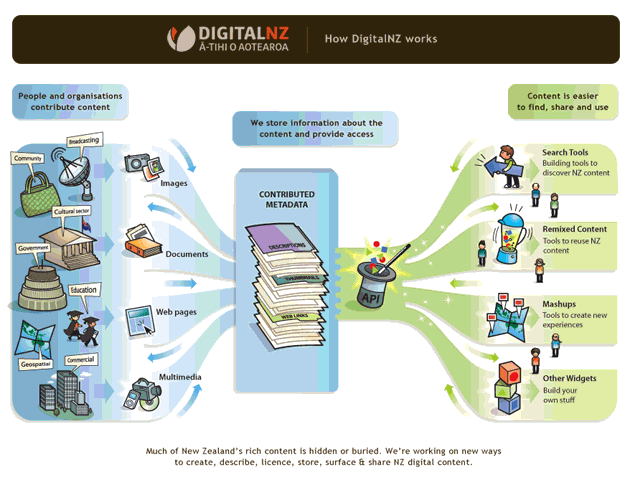The sponsor interviews – Digital New Zealand
The success of a conference is measured by the amount of ice-cream consumed! And thanks to the folks at DigitalNZ, we’ll have a big supply of Kapiti ice-cream on hand. We recently caught up with Andy Neale from DigitalNZ and asked him a few questions.
Webstock: Tell us about the story behind DigitalNZ and what your aims are?
Andy: So the sound byte for DigitalNZ is that we are helping to make NZ’s digital content easier to find share and use. The gist of this is that there’s heaps of amazing NZ material that people just don’t get to see or find. There are all the old NZ photos, and papers, and posters, and recordings etc. that needs to be digitised. So we are working on how to scale this up. Then there’s the digital material that sits in institutional databases, trapped in the dark web that Google can’t get to. So we are also going in and helping to make that content visible. We then started asking “what’s the point of finding all this amazing NZ material if you can’t do anything with it?”. That’s where our efforts to encourage the release stuff without copyright restrictions, or embrace creative commons comes in. Or heck, maybe just encourage content owners to be clear about what license or restrictions do apply. We could go on… it’s very exciting!

Webstock: DigitalNZ haz APIs. What is it and how can people start to use it? What are some of the possibilities you see with the API being made available?
Andy: We’re currently working with 35 content providers from around NZ to make their digital material more visible. Places like Te Papa and NZ On Screen have let us collect their data, and offer up for developers to access. The sky’s the limit really… we are seeing people working on location-based mashups, iPhone apps, and new tools to get this content into schools. We only launched in December so things are still getting started, but it’s kinda like, what couldn’t you do with such a dataset? We built this custom search engine on top of the APIs to give people a taste of what’s possible.
Webstock: What are some other libraries and cultural institutions doing great things online?
Andy: No surprises in saying that everyone’s been jumping on the social media bandwagon for a few years now. The Brooklyn Museum is planning something called Wikipedia Loves Art where a whole load of volunteers will take photos of materials in museums to illustrate wikipedia articles. Closer to home, Seb and the team at the Powerhouse Museum in Sydney are doing some great stuff. Their Fresh + New blog covers a lot of ground in the digital media space. And of course there’s the Commons on Flickr which started with the Library of Congress and now has more than 20 international members.
Webstock: The web team at National Library has certainly embraced the awesomeness of Twitter with a vengeance! What are some of the benefits that a team gains from using Twitter?
Andy: Yeah, it’s funny, we had a Twitter fanatic join the Library last year, and all of a sudden it just took off with a whole bunch of staff. I think mostly it’s about being visible and accessible. Granted it’s still a niche community, but we get so much from following others, and this is a way for others to get value from what we are thinking and doing. Surprisingly, it’s actually also useful when you can ask a question and 15 responses pile in with an answer.
Webstock: What speaker are you most looking forward to seeing at Webstock?
Andy: It would have to be Toby Segaran… aside from all the data-mashary and semantic goodness, he’s originally from Christchurch!
Webstock: We’re sure the Cantabrians reading are applauding that sentiment! And it’s really exciting to see a public organisation look to be open in what it’s doing.
